Aphyosemion striatum
Red-striped Killifish
SynonymsTop ↑
Haplochilus striatus Boulenger, 1911; Epiplatys striatus (Boulenger, 1911); Panchax striatus (BouAphyosemionlenger, 1911)
Etymology
Aphyosemion: from the Ancient Greek ἀφύη (aphúē), meaning ‘anchovy, a small fish’, and σημεῖον (sēmeîon), meaning ‘sign, mark’.
striatum: from the Latin striatus, meaning ‘striated, striped’.
Classification
Order: Cyprinodontiformes Family: Nothobranchiidae
Distribution
Appears restricted to the area between the lower Mitmele River, Equatorial Guinea and the lower Ogooué basin in Gabon, including coastal drainages such as the Mbei, Komo and Gabon watersheds in between.
Type locality is ‘Abanga River, between first and second rapids, Ogowe River system, Gabon’, corresponding to the Abanga River basin, a northern tributary of the middle Ogooué system in Gabon, western Africa.
Habitat
Inhabits perennial lowland (coastal) rainforest streams, pools and freshwater swamps.
Maximum Standard Length
45 – 50 mm.
Aquarium SizeTop ↑
An aquarium or container with base measurements of 45 ∗ 30 cm or upwards is recommended.
Maintenance
A dark substrate should be used and the aquarium should have dense areas of planting and pieces of wood to serve as cover. The use of floating plants to further diffuse the light is also recommended.
This species is an accomplished jumper so the cover must fit tightly.
Water Conditions
Temperature: 20 – 26 °C
pH: 6.5 – 7.5
Hardness: 54 – 215 ppm
Diet
Aphyosemion species feed largely on aquatic and terrestrial invertebrates in the wild.
In captivity small live or frozen foods such as Daphnia or bloodworm are preferred although the fish will also accept good quality flake in most cases.
Behaviour and CompatibilityTop ↑
A. striatum can be kept in a community arrangement provided tankmates are chosen with care. This is a very peaceful, relatively shy species and will easily be out-competed by more vigorous fishes.
Ideal choices include tetras, cyprinids, dwarf cichlids, Corydoras catfishes, small Loricariids and peaceful Anabantoids which grow large enough to avoid being eaten.
Sexual Dimorphism
Adult males are larger, more intensely coloured, and possess longer caudal, dorsal and anal fins than females.
Reproduction
A number of different methods have proven successful for spawning Aphyosemion species in aquaria, and much is down to personal preference. It is often recommended that a trio comprising a single male and two females should be used, but brood sizes tend to be lower under these circumstances, and it can also be bred using a single pair.
Many breeders do not use filtration, but the use of a small, air-driven sponge filter to prevent stagnation is advisable. Water should be around neutral in terms of chemistry, with a temperature within the range suggested above. There is no need to use artificial lighting.
The fish should be conditioned on a varied diet of live and frozen foods, and it is best to keep males and females apart during this process in order that females are not forced to spawn continuously. Select the best male and plumpest female before placing them in the spawning aquarium.
A. striatum deposits eggs either in the substrate or clumps of vegetation, therefore the spawning medium can either be a layer of peat moss on the floor of the aquarium, clumps of fine-leaved plants such as Taxiphylum, or artificial spawning mops. That said, a bare set-up with spawning mops is practical for both ease of maintenance and egg collection.
Eggs are deposited in daily batches of 20-30 for around 2 weeks, and these should be removed gently as they are noticed. Each pair should only be allowed to spawn for a week or so because the spawning process is hard on the fish, particularly the female.
Once removed, the eggs can be incubated either in water or by placing them on a damp layer of peat moss in a small plastic container. Fungussed eggs should be removed as they are noticed.
If incubating in water, the eggs can be transferred to a small aquarium filled to a depth of 1-2 inches from the spawning aquarium, to which has been added 1-3 drops of methylene blue depending on volume. Since the eggs are very sensitive to light this should be maintained in darkness. The eggs will hatch in 10-14 days depending on temperature.
If incubating on peat moss, place the container in a warm, dark place and simply leave it for around 18 days. If breeding several species or multiple broods, it is a good idea to label each container with the date, hatching date, species and number of eggs. Hatching can usually be induced by simply placing the eggs in water, but if this fails, blowing gently into the water through a straw or piece of airline, or placing the eggs into a small container and carrying this in your pocket for a few hours may help.
The fry are tiny and initial food should be infusoria grade. If using the peat moss incubation method, the aquarium in which the fry will grow can be ‘seeded’ a few days prior to hatching by adding a couple of drops of liquifry or green water. Otherwise add small amounts as required. After 2 days the fry can be offered Artemia nauplii, microworm, etc. The water must initially be kept very shallow but the level can be raised as the fry grow.
Extreme care must be taken regarding water quality in the raising tank as the fry are very susceptible to Piscinoodinium parasites (velvet disease). They should be fed twice a day with small water changes every 2-3 days for optimal growth.
NotesTop ↑
A. striatum is a good beginner’s killifish since it is attractive, easy to breed and is not an annual species so is relatively long-lived.
Other members of the A. striatum ‘group’ of closely-related Aphyosemion species include A. exigoideum, A. gabunense (3 subspecies), A. microphthalmum and A. primigenium.
A. striatum can be distinguished from these and other members of the genus by the following combination of characters: 9-10 dorsal-fin rays; 12-14 anal-fin rays; 30-31 longitudinal scales; dorsal-fin origin located noticeably posterior to fourth anal-fin ray; flank without irregular patches of darker scales or longitudinal dark band; caudal peduncle with 2-4 parallel, longitudinal red bands, but no ventral band; dorsal-fin with two horizontal red bands, one at the distal margin and the other at the base; caudal-fin without concentric colour pattern or vertical bars, central portion of fin with numerous red spots.
References
- Boulenger, G. A., 1911 - Annals and Magazine of Natural History (Series 8) v. 8 (no. 44): 260-268
Descriptions of new African cyprinodont fishes. - Sonnenberg, R. and T. Blum, 2005 - Bonner Zoologische Beiträge 53(12): 211-220
Aphyosemion (Mesoaphyosemion) etsamense (Cyprinodontiformes: Aplocheiloidei: Nothobranchiidae), a new species from the Monts de Cristal, northwestern Gabon. - Stiassny, M., G. G. Teugels, and C. D. Hopkins, 2007 - IRD, Publications scientifiques du Muséum, MRAC: 1-603
The Fresh and Brackish Water Fishes of Lower Guinea, West-Central Africa, Volume 2.
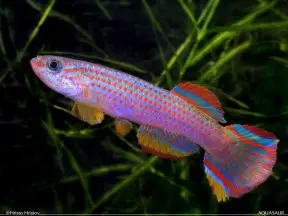
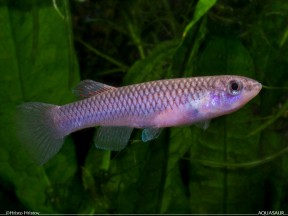


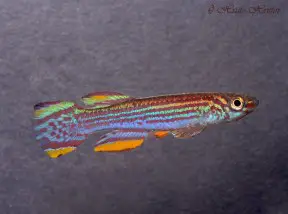

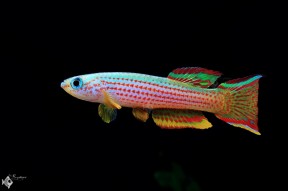
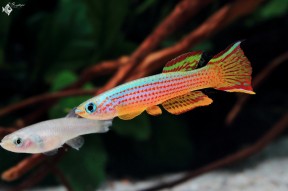
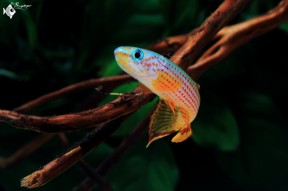
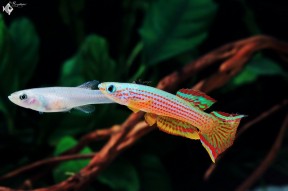

February 17th, 2014 at 8:43 pm
Very interesting article. I’m proposing moving a pair of A.Straitum to a very heavily planted 4 ft community tank with quite a bit of trepidation. (The main reason is so visitors can see these attractive fish).Inhabitants for past 6 months have been – many Endlers, 20 or so Platys a thriving and breeding colony of Cherry red shrimps and two (probably not a pair) of Scarlet Badis (Dario Dario). Funny combination – and expect the cherry shrimps to take a hit – but anyone with a view to make me worry less would be welcome and good.
November 21st, 2014 at 7:30 pm
Well first of all they certainly do not prefer soft acidic water ! They thrive much better in neutral water with 6-10º dGH . They beautiful fish and fairly easy to keep, but you have to cover the tank pretty good …they will find any hole and jump out;)
Striatum is one of the few Killis you can feed dry food and if the surounding is to his liking he is far from shy.
I wouldnt fear for the shrimps but for the endlers …they might get mistaken for concurrence , though.
November 24th, 2014 at 9:00 am
Thanks for the feedback. 🙂 Do both wild populations and aquarium strains prefer neutral water chemistry?
November 24th, 2014 at 2:31 pm
There isnt a difference …years ago my Myoko 00/32were F1 sibblings and they thrived much better in 7.2ph .
Key is that you never put them in too warm wate(+26º)and that they have only dim light, then they are happy 😀
November 24th, 2014 at 7:13 pm
Ok great, thanks for the info and I’ll edit the profile now.
November 24th, 2015 at 9:40 pm
is there a Killifish that will do well in a high current tank to go with Sewellia sp. ‘SEW01’?
November 28th, 2015 at 4:10 am
Aph. bamilekorum and elberti, Fundulopanchax puerzli and Lampeyes love current .
January 5th, 2016 at 11:09 pm
‘ello! I have a pair of A. Striatum…love them as I do, though, I must state that this species is an awful fin nipper! This pair (and a second female who has since died) managed to shred the fins of every fish in a 29 gallon community except for two female platies. Everything else was a danio or a white cloud…think they killed a white cloud or two :(. Not a good community fish.
On a more positive note, these fish are not phased by low temps at all…mine went down to 63 degrees fahrenheit without any ill effects. I have yet to successfully breed these fish, so I do not know how low temps affect spawning success.
October 13th, 2018 at 8:03 pm
The default photo isn’t indicative of how most populations of A. striatum look like in reality. That is a very washed out looking male in my opinion.
The third picture is closer to how they look like in reality. I’ve kept a few populations before.